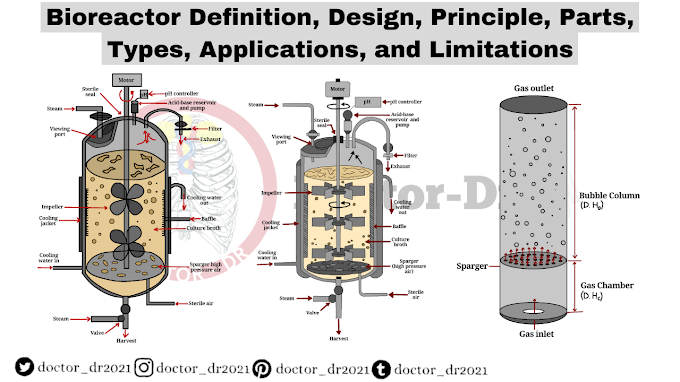by Microbiology Doctor-dr
Structure, Properties, Types, Forms, and Functions of DNA
Summary:
- DNA is an abbreviation for Deoxyribonucleic Acid, which is a molecule that holds the instructions required for an organism to develop, survive, and reproduce.
- These instructions may be discovered inside every cell and are passed down from generation to generation.
- It is a nucleic acid and one of the four primary types of macromolecules known to be necessary for all forms of life.
- In eukaryotes, DNA is located in the nucleus, with a minor quantity also present in the mitochondria.
- James Watson and Francis Crick discovered the structure of DNA in 1953.
- Rosalind Franklin's work led to Watson and Crick's discovery. Franklin was the first to notice that DNA is made up of two spirals.
- Because it resembles a twisted ladder, DNA has a double helix structure.
- The ladder's sides are constructed of alternating sugar (deoxyribose) and phosphate molecules, while the steps are built of a pair of nitrogen bases.
- Nitrogen bases are classified into four categories. DNA Pairing of Adenine (A), Thymine (T), Guanine (G), and Cytosine (C). Nitrogen bases have a distinct partnering pattern.
- Because the quantity of adenine equals the amount of thymine, and the amount of guanine equals the amount of cytosine, this pairing pattern arises. Hydrogen bonds hold the couples together.
DNA Structure and Composition in Detail
- DNA is a helix with two strands. In other words, each DNA molecule is made up of two biopolymer strands that coil around one other to form a double helix shape. These two DNA strands are known as polynucleotides because they are composed of simpler monomer units known as nucleotides.
- Each strand has a 5′ (phosphate-containing) and a 3′ end (with a hydroxyl group).
- The strands are antiparallel, which means that one strand runs in a 5′ to 3′ direction and the other in a 3′ to 5′ direction.
- The two strands are complementary to each other and are kept together by hydrogen bonds.
- DNA is made up mostly of deoxyribonucleotides.
- 3′ – 5′ phosphodiester bonds connect the deoxyribonucleotides.
- Adenine, cytosine, thymine, and guanine are the nitrogenous bases that make up deoxyribonucleotides.
- The complementary character of the strands is owing to the nitrogenous bases. Adenine always interacts with thymine (A-T) via two hydrogen bonds on the opposing strand, while cytosine always interacts with guanine (C-G) via three hydrogen bonds on the other strand.
- Hydrogen bonding and hydrophobic interactions between bases help to keep the helix form stable.
- The diameter of the double helix is 2nm, and the structure repeats at 3.4nm intervals, corresponding to 10 base pairs.
The DNA's Major and Minor Grooves
- The molecule has two asymmetric grooves due to the double helical structure of DNA. One of the grooves is narrower than the other.
- This asymmetry is caused by the geometrical arrangement of the bonds between the phosphate, sugar, and base groups, which requires the base groups to join at 120 degree angles rather than 180 degree angles.
- When the backbones are far apart, the bigger groove is termed the major groove; when they are close together, the smaller groove is called the minor groove.
- Because the major and minor grooves reveal the margins of the bases, they may be utilised to determine the base sequence of a particular DNA molecule.
- The ability to detect particular DNA sequences on which to bind is crucial because proteins must be able to recognise certain DNA sequences on which to bind in order for the body and cell to operate properly.
DNA Characteristics
- DNA helices can be either right or left handed. However, the B – conformation of DNA, with right-handed helices, is the most stable.
- When heated, the two strands of DNA separate, and when cooled, they re-hybridize.
- Melting temperature is the temperature at which the two strands entirely separate (Tm). Melting temperature varies depending on the sequence.
- Because C-G pairs contain three hydrogen bonds, the B sample of DNA must have larger C-G content.
- The base sequence throughout the DNA molecule encodes the amino acid sequence of every protein in all animals.
DNA Types
Animals, plants, and fungi store the bulk of their DNA in the cell nucleus and part of their DNA in organelles such as mitochondria.
DNA may be found in the following locations:
Nuclear DNA
- Within the nucleus of eukaryotic cells.
- There are usually two copies per cell.
- Nuclear DNA chromosomes have a linear form with open ends and 46 chromosomes holding 3 billion nucleotides.
- Nuclear DNA is diploid, meaning it is inherited from both parents. Nuclear DNA has a mutation rate of less than 0.3 percent.
Mitochondrial DNA
- The mitochondria contain mitochondrial DNA.
- Each cell has 100-1,000 copies.
- Mitochondrial DNA chromosomes are typically closed, circular structures that comprise 16,569 nucleotides in humans.
- Mitochondrial DNA is haploid, meaning it can only come from the mother.
- In general, mitochondrial DNA has a greater mutation rate than nuclear DNA.
Forms of DNA
- The majority of the DNA is in the standard Watson-Crick model, which is simply referred to as B-DNA or B-form DNA.
- Different kinds of DNA, such as A-DNA, Z-DNA, C-DNA, D-DNA, and E-DNA, have been discovered to emerge in particular conditions.
- This variation in forms is due to structural diversity.
1. B-DNA
The most frequent, as determined by X-ray diffraction of sodium salt of DNA fibres at 92 percent relative humidity.
2. A-DNA
Initially discovered by X-ray diffraction study of DNA fibres at 75% relative humidity.
3. Z-DNA
A zig-zag pattern of left-handed double helical construction winds to the left.
4. C-DNA
Formed in the presence of Li+ and Mg2+ ions at 66 percent relative humidity.
5. D-DNA
Rare variation with 8 base pairs per helical turn, forming in guanine-free structure.
6. E-DNA
Extended or atypical DNA






~1.webp)



